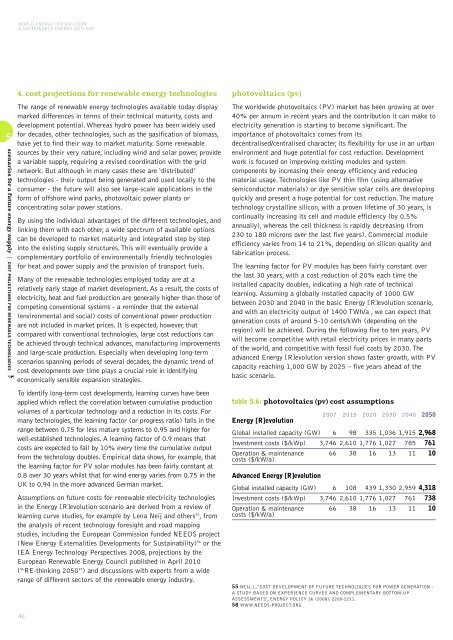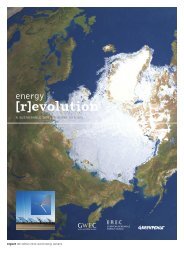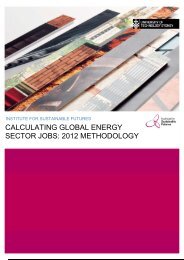download the mexico energy revolution scenario
download the mexico energy revolution scenario
download the mexico energy revolution scenario
You also want an ePaper? Increase the reach of your titles
YUMPU automatically turns print PDFs into web optimized ePapers that Google loves.
WORLD ENERGY [R]EVOLUTION<br />
A SUSTAINABLE ENERGY OUTLOOK<br />
5<br />
<strong>scenario</strong>s for a future <strong>energy</strong> supply | COST PROJECTIONS FOR RENEWABLE TECHNOLOGIES<br />
4. cost projections for renewable <strong>energy</strong> technologies<br />
The range of renewable <strong>energy</strong> technologies available today display<br />
marked differences in terms of <strong>the</strong>ir technical maturity, costs and<br />
development potential. Whereas hydro power has been widely used<br />
for decades, o<strong>the</strong>r technologies, such as <strong>the</strong> gasification of biomass,<br />
have yet to find <strong>the</strong>ir way to market maturity. Some renewable<br />
sources by <strong>the</strong>ir very nature, including wind and solar power, provide<br />
a variable supply, requiring a revised coordination with <strong>the</strong> grid<br />
network. But although in many cases <strong>the</strong>se are ‘distributed’<br />
technologies - <strong>the</strong>ir output being generated and used locally to <strong>the</strong><br />
consumer - <strong>the</strong> future will also see large-scale applications in <strong>the</strong><br />
form of offshore wind parks, photovoltaic power plants or<br />
concentrating solar power stations.<br />
By using <strong>the</strong> individual advantages of <strong>the</strong> different technologies, and<br />
linking <strong>the</strong>m with each o<strong>the</strong>r, a wide spectrum of available options<br />
can be developed to market maturity and integrated step by step<br />
into <strong>the</strong> existing supply structures. This will eventually provide a<br />
complementary portfolio of environmentally friendly technologies<br />
for heat and power supply and <strong>the</strong> provision of transport fuels.<br />
Many of <strong>the</strong> renewable technologies employed today are at a<br />
relatively early stage of market development. As a result, <strong>the</strong> costs of<br />
electricity, heat and fuel production are generally higher than those of<br />
competing conventional systems - a reminder that <strong>the</strong> external<br />
(environmental and social) costs of conventional power production<br />
are not included in market prices. It is expected, however, that<br />
compared with conventional technologies, large cost reductions can<br />
be achieved through technical advances, manufacturing improvements<br />
and large-scale production. Especially when developing long-term<br />
<strong>scenario</strong>s spanning periods of several decades, <strong>the</strong> dynamic trend of<br />
cost developments over time plays a crucial role in identifying<br />
economically sensible expansion strategies.<br />
To identify long-term cost developments, learning curves have been<br />
applied which reflect <strong>the</strong> correlation between cumulative production<br />
volumes of a particular technology and a reduction in its costs. For<br />
many technologies, <strong>the</strong> learning factor (or progress ratio) falls in <strong>the</strong><br />
range between 0.75 for less mature systems to 0.95 and higher for<br />
well-established technologies. A learning factor of 0.9 means that<br />
costs are expected to fall by 10% every time <strong>the</strong> cumulative output<br />
from <strong>the</strong> technology doubles. Empirical data shows, for example, that<br />
<strong>the</strong> learning factor for PV solar modules has been fairly constant at<br />
0.8 over 30 years whilst that for wind <strong>energy</strong> varies from 0.75 in <strong>the</strong><br />
UK to 0.94 in <strong>the</strong> more advanced German market.<br />
Assumptions on future costs for renewable electricity technologies<br />
in <strong>the</strong> Energy [R]evolution <strong>scenario</strong> are derived from a review of<br />
learning curve studies, for example by Lena Neij and o<strong>the</strong>rs 55 , from<br />
<strong>the</strong> analysis of recent technology foresight and road mapping<br />
studies, including <strong>the</strong> European Commission funded NEEDS project<br />
(New Energy Externalities Developments for Sustainability) 56 or <strong>the</strong><br />
IEA Energy Technology Perspectives 2008, projections by <strong>the</strong><br />
European Renewable Energy Council published in April 2010<br />
(“RE-thinking 2050”) and discussions with experts from a wide<br />
range of different sectors of <strong>the</strong> renewable <strong>energy</strong> industry.<br />
photovoltaics (pv)<br />
The worldwide photovoltaics (PV) market has been growing at over<br />
40% per annum in recent years and <strong>the</strong> contribution it can make to<br />
electricity generation is starting to become significant. The<br />
importance of photovoltaics comes from its<br />
decentralised/centralised character, its flexibility for use in an urban<br />
environment and huge potential for cost reduction. Development<br />
work is focused on improving existing modules and system<br />
components by increasing <strong>the</strong>ir <strong>energy</strong> efficiency and reducing<br />
material usage. Technologies like PV thin film (using alternative<br />
semiconductor materials) or dye sensitive solar cells are developing<br />
quickly and present a huge potential for cost reduction. The mature<br />
technology crystalline silicon, with a proven lifetime of 30 years, is<br />
continually increasing its cell and module efficiency (by 0.5%<br />
annually), whereas <strong>the</strong> cell thickness is rapidly decreasing (from<br />
230 to 180 microns over <strong>the</strong> last five years). Commercial module<br />
efficiency varies from 14 to 21%, depending on silicon quality and<br />
fabrication process.<br />
The learning factor for PV modules has been fairly constant over<br />
<strong>the</strong> last 30 years, with a cost reduction of 20% each time <strong>the</strong><br />
installed capacity doubles, indicating a high rate of technical<br />
learning. Assuming a globally installed capacity of 1000 GW<br />
between 2030 and 2040 in <strong>the</strong> basic Energy [R]evolution <strong>scenario</strong>,<br />
and with an electricity output of 1400 TWh/a , we can expect that<br />
generation costs of around 5-10 cents/kWh (depending on <strong>the</strong><br />
region) will be achieved. During <strong>the</strong> following five to ten years, PV<br />
will become competitive with retail electricity prices in many parts<br />
of <strong>the</strong> world, and competitive with fossil fuel costs by 2030. The<br />
advanced Energy [R]evolution version shows faster growth, with PV<br />
capacity reaching 1,000 GW by 2025 – five years ahead of <strong>the</strong><br />
basic <strong>scenario</strong>.<br />
table 5.6: photovoltaics (pv) cost assumptions<br />
Energy [R]evolution<br />
2007<br />
2015<br />
2020<br />
2030<br />
2040<br />
2050<br />
Global installed capacity (GW) 6 98 335 1,036 1,915 2,968<br />
Investment costs ($/kWp) 3,746 2,610 1,776 1,027 785 761<br />
Operation & maintenance 66 38 16 13 11 10<br />
costs ($/kW/a)<br />
Advanced Energy [R]evolution<br />
Global installed capacity (GW) 6 108 439 1,330 2,959 4,318<br />
Investment costs ($/kWp) 3,746 2,610 1,776 1,027 761 738<br />
Operation & maintenance 66 38 16 13 11 10<br />
costs ($/kW/a)<br />
55 NEIJ, L, ‘COST DEVELOPMENT OF FUTURE TECHNOLOGIES FOR POWER GENERATION -<br />
A STUDY BASED ON EXPERIENCE CURVES AND COMPLEMENTARY BOTTOM-UP<br />
ASSESSMENTS’, ENERGY POLICY 36 (2008), 2200-2211.<br />
56 WWW.NEEDS-PROJECT.ORG<br />
48



![Energy [R]evolution - European Commission](https://img.yumpu.com/49109324/1/184x260/energy-revolution-european-commission.jpg?quality=85)


![5905 gp [eu rev]csfr4.qxd - Energy [R]evolution](https://img.yumpu.com/42305023/1/184x260/5905-gp-eu-revcsfr4qxd-energy-revolution.jpg?quality=85)


![5905 gp [eu rev]csfr4.qxd - Energy [R]evolution](https://img.yumpu.com/28729264/1/184x260/5905-gp-eu-revcsfr4qxd-energy-revolution.jpg?quality=85)